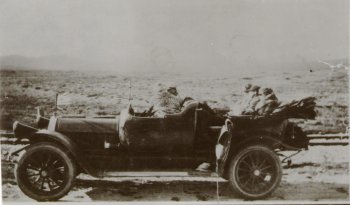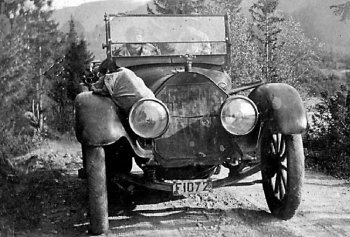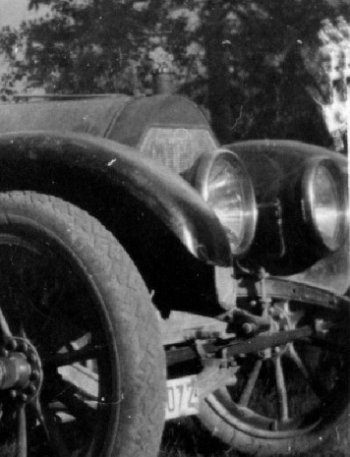- Home
- About Us
- Join/Renew
- Member Benefits
- Member Pages
- Log In
- Help
- Museum Store
I have been a member since the beginning of 1980. The restoration of my Pierce some years ago brought me into the interest of the Pierce-Arrow history in Scandinavia. I now and then find old photos of Pierce-Arrows. I am not sure if the car on the enclosed photo is a 1913 or -14 model. As the car seems to have no side lamps on the cowl I anticipate it is an early 1913. Is it a 38 or 48 model? Can anyone help me?
The car was brought to Norway shortly after the ww-1 of a norwegian-american with the name Oliver A. Roesto. He worked for Civil Aeronautics Administration for more than 30 years. He received in 1954 “Order of merit””.
Oivind Grimsmo jr./Norway”

Oivind,
The Pierce Arrow in your photo appears to be a Series 2 of 1913-1914 and it looks to have ten spokes in the front wheel which would indicate to me it is a Series C-2 or 38hp.Does this car still exist? You are no doubt familar with the C-3 that was in Oslo until recently now being restored in Denmark.
I agree with Bill Scorah, but not certain of the spoke count in the front wheels. 10 spokes would be model C, 12 would be model B
A great car.
William,
Thank you for the information, very interesting. Yes we didd have a C-3 too. The Pierce was a stab car during WW-1 in France (I suppose for the american forces?). After the war the car was among many other cars and trucks sold by auctions. A norwegian Halstein Torstein Salebakke bought this one and drove all the way hom to Norway. He used it as a “taxi” and also as a postoffice car, bringing mails out into the countryside.

Leo,
The car has 12 spokes both in front and rear. Does that mean it should be a 48-B?
Enclose another photo of the 1915 model.

Large quantities of model 38-C-3 tourings were sold to Russia in 1914 to support the war. S/N 35410-35550 (140 cars) were in production order A8 destined for Gaston, Williams & Wigmor (GWW) in Russia. S/N 35751-35825 (75 cars) were in production order A14 destined for GWW in Russia. S/N 35941-36090 (150 cars) were in production order A17 destined for GWW in Russia. Source of s/n data: Hale (employee)notebook which includes statement that not all s/n were used.
At least one of these cars (s/n 36048, 5 pass touring) has survived and resided in Norway in 1997. A second car (38-C-3 chassis/engine only) exists though chassis number has not been reported to confirm origin. Engine number C3-1899 has been reported for this car.
12 spokes on front wheels were on models A andB, 10 spokes were on model C. Model A is a 66hp,model B is a 48hp, and model C a38hp.
I am very close to the story of the Norwegian C-3 and it is a most interesting story.The serial number appears to be of the group that were shipped to Russia.Most automobiles in Russia in 1914-1915 were in the area around St.Petersburg and for many years there was a huge cultural linkage between that community and Paris,France.When the Russian Revolution took place in 1917,many of the wealthy among them no doubt some Pierce Arrow owners made their way to Paris.The Norwegian C-3 is currently being restored and in fact a correct intact frame was located in Colorado a few years ago and at this point I believe is a running chassis.It is believed that this car may be the one owned by Alexander Kerensky,the leader of the White Russians.He drove his Pierce Arrow out of Russia,then I think went to France and ultimately to Columbia University in New York City where he taught until his death about 1970 or so.I have seen a photo of him in his C-3 but it does not show the headlamps.THe Russians may have carried a preference for bracket headlamps due to their being less vulnerable and also so the car would blend in more with other vehicles.Those were interesting times.
Thank you for all the responce. This was very interesting. I can add that the chassis no. was 36048 on the model 38-C-3. The car, as I have told, was brought to Norway and received norwegian plates F-1072 allready in 1919-20 (reg. unsure). The car did have CAV-lamps. In 1947 a farmer “demolished” the car and constructed a “potatos-picker”. The frame dissapeared, most likely used for somthing else. The last norwegian owner received a large batch of parts from Australia. Correctly as William is telling he also got a frame from USA. I myself picked up a front axel at Hershey. Unfortuneatly he gave up and sold the project to Denmark.

The current owner came to the US to purchase the frame from the person in Colorado and we had a lovely visit while they were here getting photos and dimensions from my very original C-3.He is a member of PAS.It is possible the car went from Russia to France then got sold to the person from Norway.The headlamps have me curious as they do not look like the CAV’s one sees on Rolls Royce Silver Ghosts of 1914-1915.I always thought they might be Russian or French.Another possibility is that with a war waging,these cars may not have made it to Russia but were unloaded in France instead.If only these cars could talk but if someone saw this car before 1947,I would love to know more.
Interesting discussion guys!
I have a Series 5 owner’s manual printed in French and a Series 32 owner’s manual printed in Spanish. Does anybody know if the cars delivered to Russia had owner’s manuals printed in Russian? Are there any Russian manuals out there? What about manuals in other non-English languages?
Paul
Whilliam,
I am no expert on lamps. It was told from elderly people that the car did have CAV-lamps, they were later used on a entrance post at the farm. They could of cause have been changed from original in Europe. Enclosed is an enlarged photo of the cars front/lamps.
Oivind

Paul,
I do not know anything about languages on manuals etc. for export models of Pierce-Arrow. In fact I have seen (copies) of some norwegian and swedish advertising. The one enclosed is from a norwegian motor magazine of 1917.
Oivind

Oivind,
Those could very easily be CAV lamps on the Pierce Arrow.In the enlarged image,one can detect a slight inward flare to the lamp body.The owner would love to find a pair of CAV lamps for the car.
Are the car’s lamps still at that property being used for post lamps?
It was not usual for American cars in Great Britain or Europe to be fitted with British or European lamps in those days and even into more recent times.
